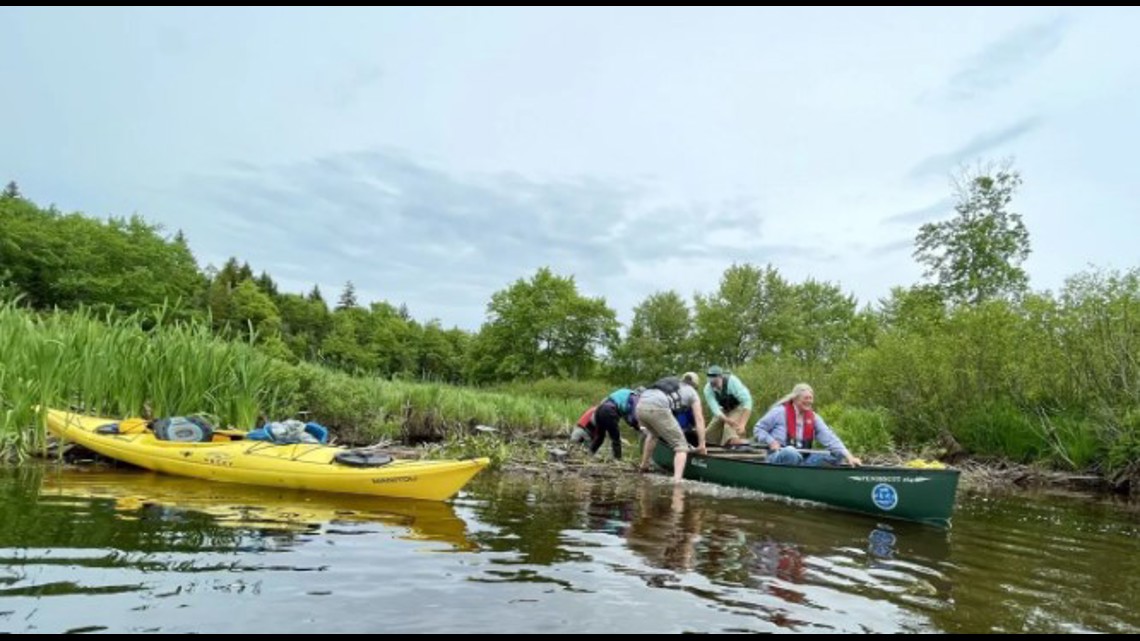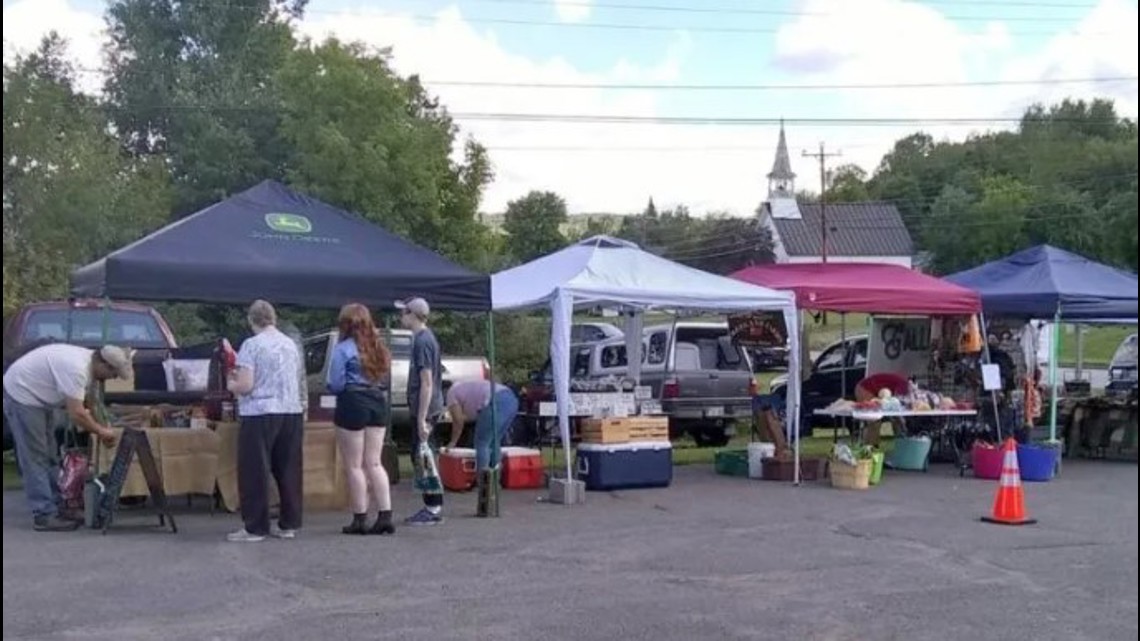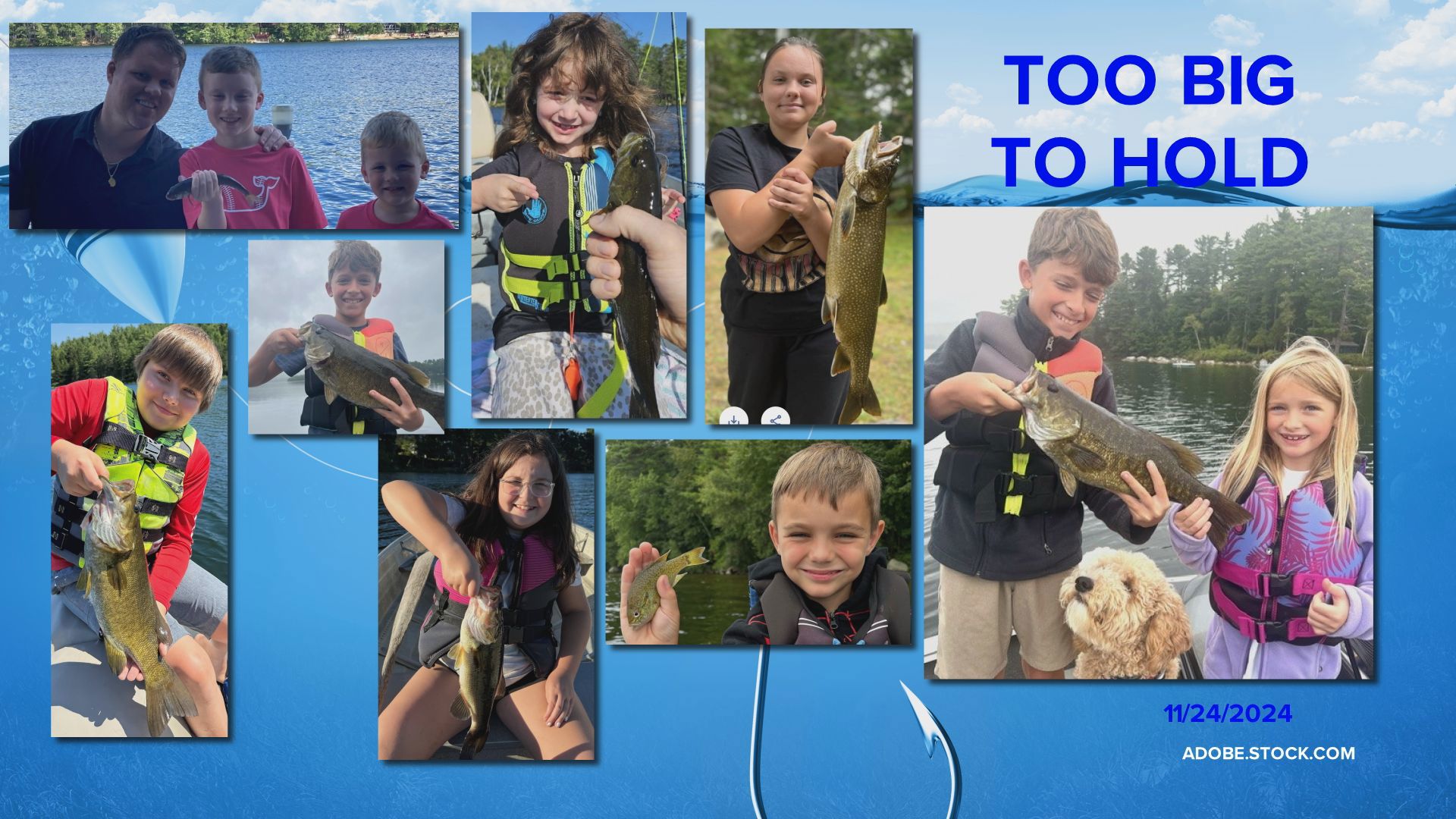MAINE, USA — The roar of summer traffic on Route 1 as it zooms over the Pleasant River bridge in Columbia drowns out the burbling water below. The slip of river meandering under the road is easy to miss.
Even less visible is the Pleasant River Fish and Game Conservation Association, tucked among the dense woods a short drive, or paddle, away. But the volunteer club has been around since the 1950s, working to preserve and promote the region’s vast natural resources.
Later this month, the association will hold its annual Puckerbrush Primitive Gathering, where about 200 visitors from near and far will come to camp and learn traditional outdoor skills.
Larry Balchen, a member of the group who helped found the event, believes Maine’s Downeast region is at an inflection point.
“There are a lot of people here who don’t really understand the value of what’s around us,” said Balchen. “They want to build attractions, but the fact that there is nothing here is the attraction.”
In the past decade, the state and roughly a dozen large nonprofit conservation groups have caught on to the idea that land and water preservation could also help boost the region’s lagging economy.
Washington County has the highest poverty rate in the state, with nearly a fifth of residents living below the poverty line, according to the 2022 American Community Survey. Hancock County, which includes Bar Harbor and Acadia National Park, is often considered part of the region, although there is debate about where Downeast begins, and different groups use different boundaries.
Far-eastern coastal Maine is rich in resources. According to the Downeast Conservation Network (DCN), the region has many of the cleanest and least developed watersheds and wildlife corridors on the East Coast. A 2018 study by University of Maine researchers for DCN reported that 19 percent of the two-county area was in some sort of conservation status — more than 700,000 acres of parks, wildlife refuges and preserves. And the figure has only grown.
Much of that conserved land and water is being groomed for public access. There has been a large uptick in recreational tourism, and thus an influx of money.
But some worry the quaint Downeast way of life, rooted largely in the fishing and wild blueberry industries, is shifting — the quiet replaced with crowds.
‘All the beautiful places’
On a cool June morning, more than two dozen kayaks and canoes converged on the once obscure Orange River in Whiting. Oars slapped the water as paddlers made their way through the winding water trail, around and sometimes over beaver dams, into Orange Lake.
The event was organized by Maine Coast Heritage Trust (MCHT), the Downeast Salmon Federation, the Downeast Coastal Conservancy, Cobscook Shores and the state Department of Inland Fisheries and Wildlife.
Jacob van de Sande, MCHT’s Washington County project manager, introduced eager paddlers to the pristine estuary teeming with fish, waterfowl and other wildlife.
MCHT manages 180,000 acres along the coast, with 19 preserves Downeast alone, including portions of the water trail where MCHT shares space with the other groups. He said the groups work together to restore fish passage from the river into Cobscook Bay, and to highlight valuable resources.
“What happens to rivers when you don’t have fish and you don’t have great access, is that people forget about them,” van de Sande said. “You forget about all the beautiful places and the great benefits this river offers to our community.”
Much attention is also being given to the land. According to the Downeast Conservation Network, roughly 16 percent of Hancock County and 28 percent of Washington County are in some form of public or private land conservation. The estimates far exceed the roughly 12 percent conserved in the state overall, putting Downeast much closer to hitting the “30×30” goal of conserving 30 percent of land by 2030.


Maine’s comprehensive outdoor recreation plan details a four-year strategy for protecting the environment while promoting ecotourism, with one goal being to “draw on (the) region’s unique assets to create or enhance experiences worthy of travel.”
The report lays out a vision for developing outdoor recreation infrastructure while building ecological resilience, noting the possibility of “simultaneously enabling long-distance trails and corridor protections; acquiring lands with enough topography to allow plant migrations while affording trail vistas; adding conserved land to coastal recreation sites at risk to sea level change; etc.”
One Lubec resident, Chris Farr, thinks the efforts are working.
When Farr, a retired medical equipment consultant, isn’t reveling in his oceanfront view of Quoddy Head Light, he takes lessons at Summerkeys, a music residency that draws people worldwide to teach and study.
Farr said participants had a hard time this summer finding housing because so many tourists came to visit Lubec’s more than 20 trails and preserves. But he thinks overall the shift has had a good effect, providing free access to parks for residents and tourists.
“You’re sort of being handed major tourist activity on a plate,” said Farr. “Personally, I think Lubec should be bending over backwards to embrace it.”
According to the Maine Office of Tourism, Downeast visitors spent more than $1.2 billion on accommodations, transportation, restaurants, shopping, entertainment, and other expenses last year — 12 percent more than the previous year.
A question of taxes
Not everyone in Lubec is sold on the change.
Still reeling from the death of its once lucrative sardine canning industry and the dwindling fisheries, the town relies on taxes from expensive oceanfront properties. In recent years, much of that property has been absorbed by nonprofit conservation groups buying the land to create preserves for hiking and other public recreation. Under state law, those conserved lands are eligible for tax exemptions.
Lubec officials say the exempt land, coupled with a nearly fourfold hike in some property assessments after a state-mandated evaluation, leaves the town struggling to fill the gap.
“The state says we’re valued at $4 billion, but $2 billion of that isn’t taxable because all these people aren’t paying taxes,” said town administrator Suzette Francis.
That deficit stems in part from property falling into “tree growth” or “open space” designations, equating to a reduction in the land’s assessed value. Sometimes conservation groups voluntarily pay reduced tax amounts, or make payments in lieu of taxes, usually far less than what would be owed without the tax breaks.
Last year, MCHT paid Lubec 20 percent of the assessed value for the three preserves it built and manages.
Cobscook Shores, meanwhile, which owns 20 parklands in Lubec, made a $2,000 donation to the town through an associated foundation. The tax bill for the group’s Red Point Nature Preserve alone would have been $6,372 last year, Francis said.
The environmental group owns about 20 miles of shorefront on Cobscook Bay and its tributaries, spanning the towns of East Machias, Lubec, Whiting, Dennysville and Pembroke, according to spokesperson Betta Stothart. Last fall, Cobscook Shores purchased the 25.5-acre Leighton farm, along Leighton Point Road and the Pennamaquan River in Pembroke, for $420,000, where it has plans for another park.
Cobscook Shores has paid reduced property taxes, and made grants to towns and community groups that total roughly $480,000 over a five-year period, according to Stothart. That’s far less than the organization would have paid without the tax breaks.
But Cobscook Shores project manager Charlie Howe points to the group’s $19 million investments in land, equipment, operations and youth programs as a different way the organization has contributed to the local economy. He said the group is trying to meet tourist demand, and noted the growing popularity of ecotourism worldwide.
“I think people, society, started realizing that they had lost the connection with the outdoors, that it can be therapeutic,” Howe said.
Overflowing parking lots
A number of conservationists acknowledged that maintaining a balance is crucial, pointing to the high levels of tourism in Bar Harbor as something many Downeast towns understandably want to avoid.
Balchen, from the Pleasant River Fish and Game Conservation Association, said he regularly hikes many Downeast trails, including the popular Cutler Coast Public Lands. The trails flirt with soaring rock ledges, offering breathtaking views of Fundy Bay.
“I remember when there was one parking lot, now there are two overflowing into the road,” Balchen said. “I used to hike the entirety of that trail without seeing a soul, but those days are gone.”
Conservation leaders say their Downeast planning efforts consider a crucial question: How do you create new recreational experiences, and new economic opportunities, while maintaining the culture of the region?


Up and down the coast, farmers and fishermen have started changing with the times, opening up farm-to-table eateries, art galleries, wedding venues, and offering visitors lobster boat rides where they can learn to pull traps.
Lisa Hanscom saw the shift start about 20 years ago. Hanscom began offering tours of Welch Farm, her family’s 18-century wild blueberry farm in Roque Bluffs.
Hanscom, who is also Washington County’s emergency management director, saw the blueberry industry was suffering, so found a way to breathe new life into the farm. Her tours bring in more than 500 visitors each season, who come to learn how to rake and pack berries. Eventually, Hanscom started renting out cabins for people who want to stay longer.
“My father wasn’t really for it in the beginning,” Hanscom said. “His exact words were, ‘Who is going to want to come stay on a farm.’ ”
Local heritage
To help protect and nurture the region’s rural culture while building an emerging tourist economy, community leaders secured a National Heritage Area designation that was signed into law late last year, the first of its kind in the state.
The legislation designates Hancock and Washington counties as an area with national importance, qualifying them for additional federal investment to help drive economic activity to the region, according to a press release announcing the designation.
The bill recognizes the contributions of Downeast Maine’s agriculture industry — including wild blueberry growers — as well as the impacts of heritage fishing and forestry, added Rep. Chellie Pingree, a co-sponsor of the bill.
Crystal Hitchings, the director of community promotion for the Sunrise County Economic Council, heads the Downeast Maine National Heritage Area project, now in the second year of a three-year planning phase.
Hitchings said the project will eventually receive about $300,000 a year in federal support for educational programming and partnerships to help sustain fishermen, farmers and others in the region’s traditional industries who must adapt to the changing climate, new technologies, and shift toward a more tourism-based economy.
Funding also will be used to help connect people with the stories, experiences and cultures rooted in Downeast’s unique natural resources.
Wayne Cox, a Pembroke shell fisherman and carpenter, is a 65-year-old 10th-generation Mainer who isn’t working after suffering a boating injury. His boat, the Earnest Lowell, is moored in his Pembroke yard amid colorful flower and rock gardens. Cox often waves to neighbors driving into the new truck stop on Route 1 near his house.
Adjusting his hat, Cox said he sees the value of ecotourism, especially in light of rising taxes and the region’s aging population. He just hopes community leaders and conservationists get it right.
“There’s a whole different way of life Downeast than there is away,” Cox said. “I’d like to see that part of it stay.”
This story was originally published by The Maine Monitor, a nonprofit and nonpartisan news organization. To get regular coverage from the Monitor, sign up for a free Monitor newsletter here.



